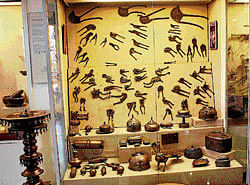
Delhi is home to at least two dozen odd museums. Almost all of them are owned by the government and their collections assembled and maintained by various government officials. Then you come across a certain Sanskriti museum – founded by a Delhi-based businessman and maintained by a board of trustees – and wonder ‘how much, after all, can a ‘private collection’ contain?’
Surprise, surprise! Reach the Sanskriti Kendra, located on the Mehrauli-Gurgaon road, and the first thing that catches your fancy is the pristine village setting – manicured lawns, a few ponds and mud houses. Then, as you go through the complex, you encounter not one, but three large museums – the Museum of Everyday Art, Indian Terracotta and Textile – each of them intelligently conceived, painstakingly assembled and passionately maintained.
The Sanskriti museums are not just an ode to Indian culture but also a testament to what an individual can achieve if he sets his heart on preserving our heritage and
traditions.
Anandagram, as it is called, was set up in 1993 by Om Prakash Jain. Om, born and brought up in Old Delhi, didn’t have much of a formal education and joined his family business of paper-trading early on. The 84-year-old informs Metrolife, “Old Delhi, as you would know, housed many aristocratic families at a point of time. These people owned beautifully carved utensils, gold and silver zari sarees and ancestral furniture. It pained me to see them sell these off for modern Western goods sans any beauty.”
“At a chance meeting with (writer) Mulk Raj Anand (in the 70s) I expressed my concern to him. Without mincing any words he said ‘Why don’t you do something? It will be a pity to die a shopkeeper after having so much awareness.’ From that day onwards, I started collecting these items. People used to call me a kabadiwallah but I went from door to door gathering these things lest they land up in a furnace.”
Om first set up a small museum in the basement of his Kinari Bazar house in ‘84. Then the artefacts were shifted to the Kendra when it came up 10 years on, and today these form the Museum of Everyday Art.
The genius of Indian craftsmanship, which combines utility with beauty and skill, is amply evident in these objects. These are also wisely placed in the order of their use in a person’s life. First we see articles of kids’ use – a beautifully carved wooden walker, a life-like brass bullock cart and pichkari. Then come items of a student’s use: brass inkpots and fine stylus, palm leaves with inscriptions, ancient-looking compass and even brass geometry boxes.
Then come objects of an adult’s use – hookahs with Southern India’s bidri work (silver inlay work on black metal), at least 100 varieties of areca nut crackers and paandaan all in exquisite designs, kitchen items – chaklas (rotimakers) with lotus motifs even on the back, coconut scrapers, ornate bronze ghada (pots), silver glasses, thalis (plates) and stoves.
Other household items are as interesting: cloth ceiling fans drawn through a thread, outsized locks and latches in the shapes of swans, peacocks and trishul, trunks, bird cages, jewellery boxes, hair pins and mirrors of polished metals. Lastly come articles of an aged person’s use when spirituality takes over. There are small torans (temple gateways), domestic shrines, puja utensils, conch shells and other religious articles.
Om says, “These objects are gems from our past. They are pointers to our society’s immense skill and talent. It is important that we preserve them, lest we should lose all reference to them for
the future.”